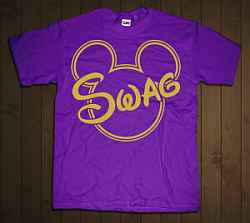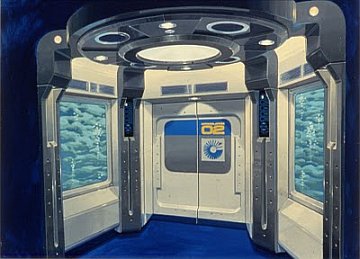About the Column
For years, Jeff Heimbuch has been writing about Disney. Many of his articles have appeared in Celebrations Magazine. But Jeff has always had a little '626' inside him anxious to come out. Unlike his column's namesake, Stitch, he might not paint the Castle blue, but he will paint the park red with entertaining stories, fascinating insights, and daring ... experiments.
Disney Swag: The T-Shirt

Get yours now!
Disney Swag: The T-Shirt

Get yours now!
Classic Disney Dispatch Content
 Review: A Walk in the Park with Rolly Crump
Review: A Walk in the Park with Rolly Crump
 Disney Dreadful: The Bus Beast
Disney Dreadful: The Bus Beast
Disney Dispatch Columns
 Because I Stinkin' Love Disney World
Because I Stinkin' Love Disney World
 Disney Travel Tips from Mouseketrips
Disney Travel Tips from Mouseketrips
Subscribe to Disney Dispatch Digest
And receive a daily email summary of new stuff on the site.
The Living Seas
Jeff Heimbuch harks back to the harrowing hydrolator
"We welcome you to The Living Seas. We welcome you to Seabase Alpha."
And with those words, we were transported to a world under the sea...
Not a world filled with singing crustaceans and red-headed mermaids. That's reserved for cartoons. I'm talking about the REAL DEAL: a living, breathing seabase, teeming with life and research.
Fantastically enough, it all took place at Epcot.
Well, maybe we weren't exactly under the sea, but amazing things did happen, and long before computer-generated fish swam in to stake their claim.
And It Rained...
January 2010 was the 25th Anniversary of The Living Seas Pavilion. I'm a little late to the party on this one, but I thought it might be a good time to explore the past of one of Epcot's most treasured Pavilions.
Although The Living Seas was designed by Imagineers, they had a team of oceanographers, marine biologists, and other experts to help them to create an undersea world on dry land. Before it was surpassed by the Georgia Aquarium in 2005, The Living Seas boosted the world's largest artificial saltwater tank, containing over 70 species of aquatic life swimming in 5.6 million gallons of sea water. The main coral reef is just about 203 feet in diameter and 27 feet deep.
Nothing at Disney is done half-way, and so even today, The Living Seas is a site to behold!
The original pavilion had you enter a queue decorated with various props  from the 1954 film 20,000 Leagues Under The Sea. At the end, you were ushered into a theatre for a seven minute film about the mysteries of the oceans and how they effect our lives in ways we might not have even imagined. If you remember this film, it's probably because of the infamous line: "And it rained..."
from the 1954 film 20,000 Leagues Under The Sea. At the end, you were ushered into a theatre for a seven minute film about the mysteries of the oceans and how they effect our lives in ways we might not have even imagined. If you remember this film, it's probably because of the infamous line: "And it rained..."
To the Hydrolators!
When the film was over, you were taken to the hydrolators, capsules which would 'descend' to the ocean floor using an effect similar to the Haunted Mansion's stretching portrait room.
Outside the hydrolator's strategically placed windows, a conveyer belt painted with 'rocks' move upward while bubbles floated past and the floor shook just slightly.
Put it together and you had quite the realistic illusion that the hydrolator was taking you down into the ocean depths.
From there, you boarded Seacabs for the short trip to Seabase Alpha. These cabs followed the same track as today's Nemo ride but with one slight difference: instead of Nemo and his friends popping up during your journey, the Seacabs took you through a tunnel with the coral reef  visible through six-inch thick windows.
visible through six-inch thick windows.
Welcome to Seabase Alpha
Upon arrival at Seabase Alpha, you were encouraged to explore this underwater research facility. You could watch another film about harnessing oceanic resources, check out the many exhibits, view demonstrations in the airlock, or watch divers performing studies on the coral reef from a breath-taking, two-story viewing area.
The Living Seas exemplified one of Walt Disney's early philosophies: disguise learning as fun.
They say that what goes up must come down, but the opposite applied here: when you left Seabase Alpha, you had to ride the hydrolators to 'return' to the surface. While in the hydrolator, you could look up to the 'glass ceiling' to see the water's surface come into view from above.
Nemo Finds the Living Seas
In 1998, The Living Seas lost its sponsor, United Technologies, who had been financing the exhibit since it opened in 1986. Without a sponsor, the pavilion began to decay. The Seacabs were removed in 2001, and eventually the hydrolators became optional - you no longer had to ride them to reach Seabase Alpha. But without the hydrolators, the illusion of entering an undersea world was lost.
With the success of Disney/Pixar's Finding Nemo, Disney decided to revitalize its dying pavilion by adding characters that kids knew and loved. In late 2006, The Living Seas became The Seas with Nemo and Friends. The new ride used the same track as the Seacabs, though now slightly lengthened. These new  Clam-mobiles also faced sideways (the Seacabs faced forward).
Clam-mobiles also faced sideways (the Seacabs faced forward).
Disney also added the popular show, Turtle Talk with Crush, as part of its Living Character Initiative. In what is quite possibly now the highlight of the pavilion, guests are brought into the 'human tank' to interact with Crush using cameras placed throughout the room and a live actor backstage playing the role of Crush.
The Seas is also home to one of the nicest restaurants on Disney property, the Coral Reef, where you can enjoy a meal surrounded by stunning underwater views of the Caribbean Coral Reef.
If you happen to be an experienced (and certified!) SCUBA diver, you can experience the reef from the other side of the glass! This special attraction lasts about three hours and includes a behind-the-scenes tour of the aquarium, a guided underwater tour of the reef, and some free time for you to explore the tank youself.
Though the educational aspect of the pavilion has been reduced, The Seas still provides some unique learning experiences as well as an up-close look at what goes on beneath the water's surface.
Feel free to follow me on Twitter for updates!
 For more, visit the homepage of THE 626
For more, visit the homepage of THE 626
Stuff Not to Skip
- The Seas with Nemo & Friends
http://disneyworld.disney.go.com/parks/epcot/attractions/the-seas-with-nemo-and-friends - Jeff Heimbuch's Bamfer Productions
http://www.bamferproductions.com





